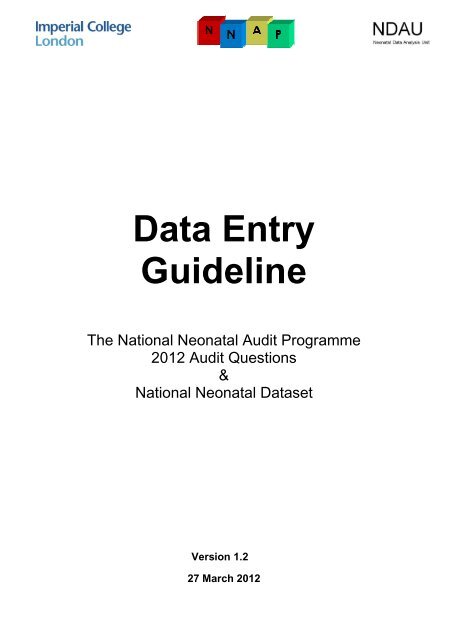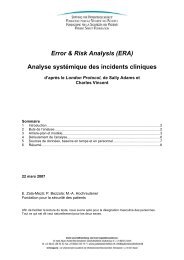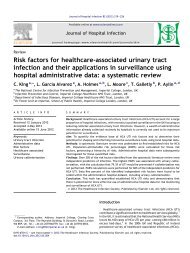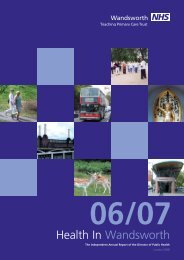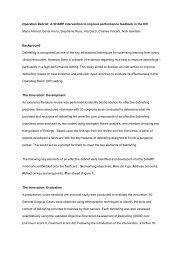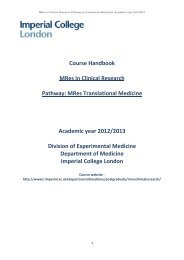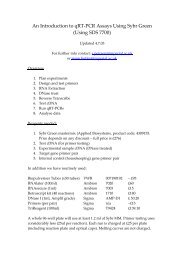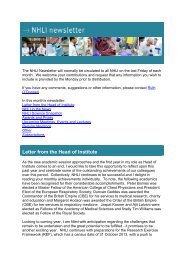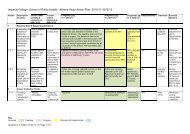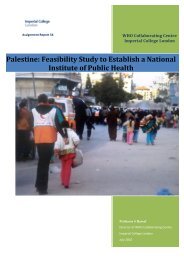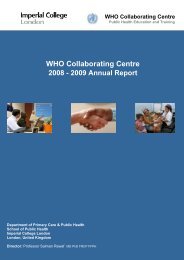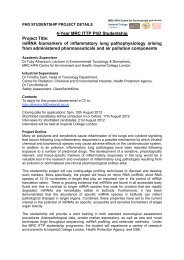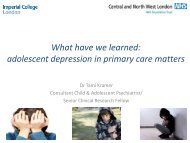Data Entry Guideline
Data Entry Guideline
Data Entry Guideline
You also want an ePaper? Increase the reach of your titles
YUMPU automatically turns print PDFs into web optimized ePapers that Google loves.
Question 1Do all babies of less than or equal to 28 +6 weeks have their temperaturetaken within an hour after birth?Eligible babies:• Discharged from neonatal care in 2012• Babies with a gestational age ≤28 +6 weeks• Admitted within ≤1 hour of birth to a NNAP participating neonatal unit• Reported by hospital of birth<strong>Data</strong> Source:• General details formo Anonymous IDo Gestation Weekso Gestation Dayso Final NNU Outcome• Admission details formo Date of admissiono Was temperature measuredafter admissiono Date and time of first temperaturemeasureo Value of first temperature measure• General Discharge formo Date and time of discharge or deatho Discharge destinationNNAP Analysis <strong>Guideline</strong>s: 2012 Audit Questions & National Neonatal <strong>Data</strong>set 6
Question 4What proportion of babies of
Question 9What percentage of babies admitted to a neonatal unit have: (a) one ormore episodes of a pure growth of a pathogen from blood, (b) one ormore episodes of a pure growth of a pathogen from CSF, and (c) either apure growth of a skin commensal or a mixed growth with ≥3 clinicalsigns at the time of blood sampling?Eligible babies:• Discharged from neonatal care in 2012• All babies with an adhoc Culture form data entry• Reported by hospital of culture sample<strong>Data</strong> Source:• General details form (please see Appendix page 19)o Anonymous IDo Gestation weekso Gestation days• Admission details form (please see Appendix page 29)o Date and time of admissiono Hospital baby admitted fromo Primary reason for admissiono Hospital providing care (derived)• General Discharge form (please see Appendix page 32)o Date and time of discharge or deatho Discharge destination• Ad-hoc form: Infection/Cultureo Sample taken date and timeo Sample typeo Signs present when cultureobtainedo Pathogenso Sensitivity list for isolatesNNAP Analysis <strong>Guideline</strong>s: 2012 Audit Questions & National Neonatal <strong>Data</strong>set 14
Question 11How many blood stream infections a are there on a NNU per 1000 days ofcentral line b care?aAs defined in the standard question about blood cultures – “The growth of a recognised pathogen inpure culture, or in the case of a mixed growth, or growth of skin commensal, the added requirementfor 3 or more of 10 predefined clinical signs"b central line = UAC, UVC, percutaneous long line or surgically inserted long line.Eligible babies:• Discharged from neonatal care in 2012• All babies with an adhoc Culture form and Line in situ data entry• Reported by hospital of culture sample<strong>Data</strong> Source:• General details form (please see Appendix page 19)o Anonymous IDo Gestation weekso Gestation days• Admission details form (please see Appendix page 29)o Date and time of admissiono Hospital baby admitted fromo Primary reason for admissiono Hospital providing care (derived)• General Discharge form (please see Appendix page 32)o Date and time of discharge or deatho Discharge destination• Ad-hoc form: Infection/Culture (please see Appendix page 35)o Sample taken date and timeo Sample typeo Signs present when culture obtainedo Pathogenso Sensitivity list for isolates• Extended daily summary formo Day of care (derived)o Line in situ todayNNAP Analysis <strong>Guideline</strong>s: 2012 Audit Questions & National Neonatal <strong>Data</strong>set 16
AppendixNational Neonatal <strong>Data</strong>set
AppendixIntroductionThe National Neonatal Audit Programme (NNAP) and the National Neonatal <strong>Data</strong> Analysis Unit(NDAU) utilise the National Neonatal <strong>Data</strong>set for national audits, service and outcomeevaluations. It is populated from electronic patient data entered on the Neonatal.Net(https://nww.neonatal.nhs.uk) platform. The accompanying images of the platform, operated byClevermed, Ltd, demonstrate the location of the data entry for reporting. Fields marked withyellow arrows will be used to produce reports on 2012 NNAP data while the fields marked withgreen arrows are part of the National Neonatal <strong>Data</strong>set used for audit development work.All screen shots are produced from a test record.National Neonatal <strong>Data</strong>set 18
Screen: General baby detailsScreen: General baby details (continued)National Neonatal <strong>Data</strong>set (for NNAP 2012)National Neonatal <strong>Data</strong>setNational Neonatal <strong>Data</strong>set 19
Screen: Parent detailsScreen: Parent details (continued)National Neonatal <strong>Data</strong>set (for NNAP 2012)National Neonatal <strong>Data</strong>setNational Neonatal <strong>Data</strong>set 20
Screen: GP and other related care professionalsScreen: Biochemical /Blood spot ScreeningNational Neonatal <strong>Data</strong>set (for NNAP 2012)National Neonatal <strong>Data</strong>setNational Neonatal <strong>Data</strong>set 21
Screen: 2 Year follow upScreen: 2 Year follow up (continued)National Neonatal <strong>Data</strong>set (for NNAP 2012)National Neonatal <strong>Data</strong>setNational Neonatal <strong>Data</strong>set 22
Screen: 2 Year follow up (continued)Screen: 2 Year follow up (continued)National Neonatal <strong>Data</strong>set (for NNAP 2012)National Neonatal <strong>Data</strong>setNational Neonatal <strong>Data</strong>set 23
Screen: 2 Year follow up ( Bailey III continued)Screen: 2 Year follow up (continued)National Neonatal <strong>Data</strong>set (for NNAP 2012)National Neonatal <strong>Data</strong>setNational Neonatal <strong>Data</strong>set 24
Screen: 2 Year follow up (Schedule of Growingcontinued)Screen: 2 Year follow up ( Neurosensorycommunication continued)National Neonatal <strong>Data</strong>set (for NNAP 2012)National Neonatal <strong>Data</strong>setNational Neonatal <strong>Data</strong>set 25
Screen : PregnancyScreen: Pregnancy (continued)National Neonatal <strong>Data</strong>set (for NNAP 2012)National Neonatal <strong>Data</strong>setNational Neonatal <strong>Data</strong>set 26
Screen: Pregnancy (antenatal screening continued)Screen: Previous PregnanciesNational Neonatal <strong>Data</strong>set (for NNAP 2012)National Neonatal <strong>Data</strong>setNational Neonatal <strong>Data</strong>set 27
Screen: Labour and delivery details formScreen: Labour and delivery details form(continued)National Neonatal <strong>Data</strong>set (for NNAP 2012)National Neonatal <strong>Data</strong>setNational Neonatal <strong>Data</strong>set 28
Screen: Admission details formScreen: Admission details form (continued)National Neonatal <strong>Data</strong>set (for NNAP 2012)National Neonatal <strong>Data</strong>setNational Neonatal <strong>Data</strong>set 29
Screen: Clinical summary of stayScreen: Clinical summary of stay (continued)National Neonatal <strong>Data</strong>set (for NNAP 2012)National Neonatal <strong>Data</strong>setNational Neonatal <strong>Data</strong>set 30
Screen: Clinical summary of stay (continued)Screen: Clinical summary of stay (continued)National Neonatal <strong>Data</strong>set (for NNAP 2012)National Neonatal <strong>Data</strong>setNational Neonatal <strong>Data</strong>set 31
Screen: General/Core discharge details formScreen: General/Core discharge details form (‘ifbaby died’ continued)National Neonatal <strong>Data</strong>set (for NNAP 2012)National Neonatal <strong>Data</strong>setNational Neonatal <strong>Data</strong>set 32
Screen: General/Core discharge details form(continued)Screen: General/Core discharge details (continued)National Neonatal <strong>Data</strong>set (for NNAP 2012)National Neonatal <strong>Data</strong>setNational Neonatal <strong>Data</strong>set 33
Screen: Abdominal X-ray performedScreen: Cranial USS formNational Neonatal <strong>Data</strong>set (for NNAP 2012)National Neonatal <strong>Data</strong>setNational Neonatal <strong>Data</strong>set 34
Screen: Hearing test formScreen: Infection (culture) formNational Neonatal <strong>Data</strong>set (for NNAP 2012)National Neonatal <strong>Data</strong>setNational Neonatal <strong>Data</strong>set 35
Screen: ROP ScreenScreen: Vaccinations givenAll items belowAll items belowNational Neonatal <strong>Data</strong>set (for NNAP 2012)National Neonatal <strong>Data</strong>setNational Neonatal <strong>Data</strong>set 36
Screen: Patient <strong>Data</strong> (New tab)To edit an ad hoc form such as Infection (culture), select ‘Patient data’ (redcircle 1) and then ‘Daily data’ (red circle 2).Screen: Patient <strong>Data</strong> (New tab)Select the day which has had an ad hoc form filled out ( ) to edit thescreen.12National Neonatal <strong>Data</strong>set (for NNAP 2012)National Neonatal <strong>Data</strong>setNational Neonatal <strong>Data</strong>set 37
Screen: Extended daily summaryScreen: Extended daily summary (continued)National Neonatal <strong>Data</strong>set (for NNAP 2012)National Neonatal <strong>Data</strong>setNational Neonatal <strong>Data</strong>set 38
Screen: Extended daily summary (continued)Screen: Extended daily summary (continued)National Neonatal <strong>Data</strong>set (for NNAP 2012)National Neonatal <strong>Data</strong>setNational Neonatal <strong>Data</strong>set 39
Screen: Extended daily summary (continued)Screen: Extended daily summary (continued)National Neonatal <strong>Data</strong>set (for NNAP 2012)National Neonatal <strong>Data</strong>setNational Neonatal <strong>Data</strong>set 40


